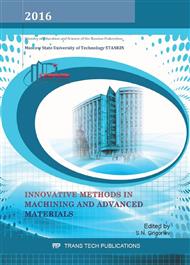[1]
S.B. Maslenkov, Heat-resistant steels and alloys. Handbook, Metallurgy, (1988).
Google Scholar
[2]
E.A. dy K-H Grote son, Springer Handbook of Mechanical Engineering ed. son 1576 p. Chapter 3, Materials and Engineering. (2009) 75-218.
Google Scholar
[3]
A.M. Adaskina, V.N. Butrim, V.V. Kashirtsev, K.V. Kryuchkov, The choice of tool material for machining super alloy H65NVFT, STIN. 12 (2013) 31-35.
Google Scholar
[4]
A.M. Adaskin, A.A. Vereshchaka, A.S. Vereshchaka, Study of Wear Mechanism of Hard Alloy Tools during Machining of Refractory Alloys, Friction and Wear. 34 (2013) 208–213.
DOI: 10.3103/s1068366613030021
Google Scholar
[5]
A.M. Adaskin, V.N. Butrim, A.S. Vereshchaka, A.K. Kirillov, Influence of the Blank's Elastic Modulus on the Cutting Forces in Turning, Russian Engineering Research. 34 No. 12 (2014) 829-831.
DOI: 10.3103/s1068798x1412003x
Google Scholar
[6]
A.M. Adaskin, V.N. Butrim, Study of Wear rate of cutting tools made from chromium based high temperature alloy during operation depending on the material properties of the cutting tool and the rate of cutting, Friction and Wear. 35 No. 5 (2014).
DOI: 10.3103/s106836661405002x
Google Scholar
[7]
A.M. Adaskin, V.N. Butrim, A.A. Vereshchaka, A. S Vereshchaka, V.V. Kashirtsev, Effect of cutting speed on chip formation in turning of super alloys based on nickel and chromium, STIN. 10 (2014) 23 -27.
DOI: 10.3103/s1068798x15040036
Google Scholar
[8]
A.S. Vereshchaka, A.A. Vereshchaka, Improved efficiency of cutting tools by controlling the composition, structure and properties of coatings, Strengthening technology and coating. 9 (2005) 9-18.
Google Scholar
[9]
K. Bouzakis, N. Michailidis, G. Skordaris, E. Bouzakis, D. Biermann, R. M'Saoubi, Cutting with coated tools: Coating technologies, characterization methods and performance optimization, CIRP Annals - Manufacturing Technology. 61 (2012) 703–723.
DOI: 10.1016/j.cirp.2012.05.006
Google Scholar
[10]
A.M. Adaskina, V.N. Butrim, I. Yu. Sapronov, Phase transformations, structure and properties of the alloy H65NVFT based on chromium, Metal Physics and Advanced Technologies. 35 No. 11 (2013) 1001-1012.
Google Scholar
[11]
T.M. Trent, Metal cutting, Butterworths, Engineering – Moscow, (1980).
Google Scholar
[12]
I.N. Chaporova, V.I. Kudriavtsev, Z.N. Sapronova. Investigation of the structure and properties of the alloys on the base of the system W-C-Re-Co, Scientific publication of VNIITS. Moscow, Metallurgy. 245 (1984) 7-9.
Google Scholar
[13]
A.M. Adaskin, A.I. Anikeev, A.S. Vershchaka, V.V. Kashirtsev, I. Yu. Sapronov, Optimal rhenium content in carbides used to cut high-temperature steel and alloys, Russian Engineering Research. 33 (2013) 499-503.
DOI: 10.3103/s1068798x13080030
Google Scholar
[14]
The phase diagrams of binary metallic systems/ ed. N.P. Lyakishev. Mechanical engineering, (2001).
Google Scholar
[15]
V.I. Tretyakov, Fundamentals of metallurgy and manufacturing of sintered carbide, Metallurgy, (1976).
Google Scholar
[16]
R. Kiefer, F. Denesovsky, Hardmetalle, Springer-Vertag, (1965).
Google Scholar
[17]
A. A. Vereschaka, Development of Assisted Filtered Cathodic Vacuum Arc Deposition of Nano-Dispersed Multi-Layered Composite Coatings on Cutting Tools Development of Assisted Filtered Cathodic Vacuum Arc Deposition of Nano-Dispersed Multi-Layered Composite Coatings on Cutting Tools, Key Engineering Materials. 581 (2014).
DOI: 10.4028/www.scientific.net/kem.581.62
Google Scholar
[18]
A.A. Vereschaka, S.N. Grigorieva, A.S. Vereschaka, A. Yu. Popov and A.D. Batako, Nano-scale multi-layered composite coatings for cutting tools operating under heavy cutting conditions, Procedia CIRP 14. (2014) 239 – 244.
DOI: 10.1016/j.procir.2014.03.070
Google Scholar
[19]
J. Vetter, W. Burgmer, H. Dederichs, A. Perry, The architecture and performance of compositionally gradient and multi-layer PVD coating, Mater Sci Forum. (1994) 527–532.
DOI: 10.4028/www.scientific.net/msf.163-165.527
Google Scholar
[20]
G.S. Fox-Robinovich, A. Kovalev, M.H. Aguirre, Design and performance of Al TiN and Ti Al Cr N PVD coating for machining hard to cut materials, Surf. Coat. Technol. 204 (2009) 489-496.
DOI: 10.1016/j.vacuum.2009.06.019
Google Scholar


